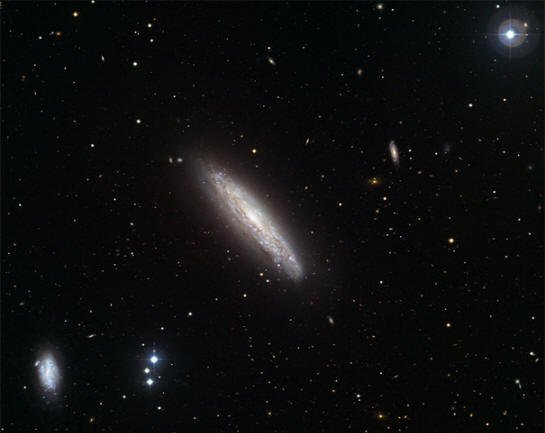|

Galaxy NGC 4666, thought to be about
80 million light-years from Earth.
Credit: ESO.
Double Layer Acceleration
Sep 15, 2010
Instead
of gaseous "superwinds," astronomers
are witnessing the acceleration of
particles from plasma double layers.
A recent
press release states that
NGC 4666 (above) is blowing a
“superwind” of hot gas outward from
the galaxy's energetic central
bulge. It is so hot, according to
astronomers from the European
Southern Observatory (ESO), that it
is emitting copious X-rays and radio
waves. Since those wavelengths are
not visible to the naked eye, the
European Space Agency's XMM-Newton
space telescope saw them first,
prompting ESO to capture a
visible-light image with its Wide
Field Imager located in Paranal,
Chile.
According to ESO, "A combination
of supernova explosions and strong
winds from massive stars in the
starburst region drives a vast flow
of gas from the galaxy into space."
To say that gas can be heated
until it emits X-rays that "blow
like a wind” indicates a serious
lapse on the part of ESO's research
team. Molecules of gas cannot remain
intact at million degree
temperatures because electrons are
stripped from the atomic nuclei,
causing them to become ionized.
Instead of hot gas, the galactic
surge should be referred to by its
proper name: plasma.
Irrespective of their source,
X-rays in space are not created by
gravitational fields regardless of
how strong they are theorized to be.
Since plasma is composed of charged
particles, the particles are
accelerated by electric currents and
spiral in the resulting magnetic
fields, creating synchrotron
radiation that can shine in all high
energy frequencies, including
extreme ultraviolet, X-rays, and
gamma rays.
Electric power flows along the
spiral arms of a
galactic circuit where it
is concentrated and stored in a
central plasmoid within the galactic
bulge. When the current density
reaches a critical threshold, it
discharges along the galaxy’s spin
axis as an energetic jet of plasma.
That phenomenon has been replicated
in the laboratory with a
plasma focus device.
When plasma moves through a dust
or gas, the cloud becomes ionized
and electric currents flow. The
currents generate magnetic fields
that confine themselves into
coherent filaments known as
Birkeland currents. The charged
particles that compose the currents
spiral along the magnetic fields,
appearing as electrical vortices.
The forces between these spinning
Birkeland currents pull them close
together and wind them around each
other into ‘plasma
ropes'.
Birkeland currents squeeze
galactic plasma into thin
filaments that remain
collimated over great distances.
Indeed, ESO's observations reveal
that the material from NGC 4666
travels more than 30,000 light-years
from its source, but that estimate
could be off by a significant factor
because of problems with
redshift distance
estimates. Jets usually end in
so-called "radio lobes" that extend
for many times a galaxy's diameter
and, as mentioned, radiate copiously
in
radio frequencies. The
diffuse current then flows back
around toward the galaxy’s
equatorial plane and spirals into
its nucleus.
Don Scott, author of
The Electric Sky, wrote
about the way plasma acts in the
Universe:
“Plasma phenomena are scalable.
Their electrical and physical
properties remain the same,
independent of the size of the
plasma. In a laboratory plasma, of
course, things happen much more
quickly than on, say, galaxy scales,
but the phenomena are identical—they
obey the same laws of physics. In
other words we can make accurate
models of cosmic scale plasma
behavior in the lab, and generate
effects that mimic those observed in
space. It has been demonstrated that
plasma phenomena can be scaled to
fourteen orders of magnitude. (Alfvén
hypothesized that they can be scaled
to 28 orders or more!) Electric
currents flowing in plasmas produce
most of the observed astronomical
phenomena that remain inexplicable
if we assume gravity and magnetism
to be the only forces at work.”
Hannes Alfvén identified the
"exploding double layer" as a new
class of celestial object. Double
layers in space plasmas form most of
the unusual structures we see.
Stephen Smith
|







